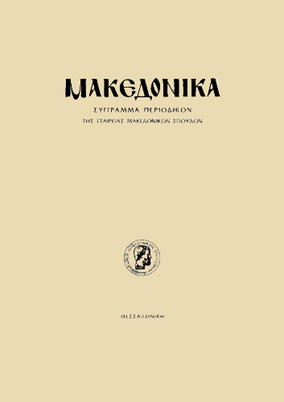Οι οικισμοί της περιοχής των Σερβιών και τα ονόματα των αφιερωτών τους στην πρόθεση 421 της μονής της Μεταμόρφωσης των Μετεώρων : (1592/93-19ος αι.)
Part of : Μακεδονικά ; Vol.32, 2000, pages 185-203
Issue:
Pages:
185-203
Parallel Title:
The Settlements in the Servie. Area and the Names of Dedicants from them in Prothesis 421 of the Monastery of the Transfiguration at Meteora (1592/93 - 19th cent.).
Section Title:
Articles
Author:
Abstract:
On the basis of a manuscript containing entries ranging in date from the year 1592/93 up to the 19th century, the writer presents 31 settlements within the jurisdiction of the Diocese of Servia and the names of inhabitants from them who were recorded as being dedicants of the Monastery of the Transfiguration at Meteora. Of the 31 settlements, 11 no longer exist (of these 7 have proved to be unidentifiable). 21 of them are mentioned in the initial entry (i.e. that of 1592/93), thereby providing a terminus ante quern for the date of their foundation. The others are mentioned in later entries, not all of which are precisely dated. As for the dedicants, there are 109 in total (56 men and 53 women) for the period 1592/93 and 217 (121 men and 96 women) for the 17th-19th cent, period. After 13 names (8&5) were subtracted from those mentioned in the initial entry, and 6 (4&2) from those mentioned in the 17th- 19th cent, period, owing to the fact that these were the names of monks and nuns, comments have been provided on the remainder, which consists of 26 men’s names and 30 women’s names borne by 48 men and 48 women in the initial entry, and 41 men’s names and 55 women’s names borne by 125 men and 94 women in the subsequent entries. The names were divided into the following categories: a) names from the ecclesiastical tradition; b) names from the folk tradition; c) names from historical characters; d) names from offices and occupations; e) foreign and unclassifiable names. In both cases, more than half of the men’s names come from the ecclesiastical tradition. As for the women, a little less than half of the names appearing in the initial entry come from the folk tradition, whereas in the subsequent entries a little less than half come from the ecclesiastical tradition.
Subject (LC):
Notes:
856:https://ejournals.epublishing.ekt.gr/index.php/makedonika/article/view/5731, DOI: https://doi.org/10.12681/makedonika.170
Electronic Resources:




